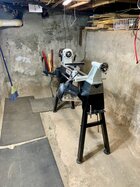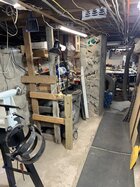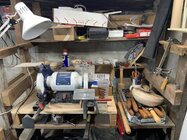I'm getting the new lathe set up
Hello Matt! Looks like a cozy space.
It’s difficult to to think about designing a turning space without being there and seeing it. However, over the years I’ve slowly refined some things that worked for me by experimenting in three different shop areas, one quite “tight”! BTW, I prefer to turn small, detailed things - I”m not overly focused on big bowls and hollow forms.
This is the main lathe space in my latest (and hopefully my last) shop - I’m getting too old to build another shop. I was fortunate to have a good spot near the barn big enough to build a 24x62’ shop. (I tell people I built it with my bare hands but I lie - I used tools!

) There is room for turning, sharpening, bandsaw, drum sander, dust collection, big air compressor, office, flatwood tools, electronics repair, small welding shop, little machine shop, and a huge amount of wood storage. (I also incubate and hatch peacock and guinea eggs in the shop and raise them inside until big enough to go in cages outside) I put up two walls to define the rectangular turning space, about 8’x12’, room for two lathes, workbench, tools, and supplies. Sharpening is on the far wall across the room. .At the lathe are three adjustable lights and two up higher in reflectors I can aim where needed.
The main point of this photo is to show how I like tp have many things within arms’ reach. I use magnets a lot to hold things.

Some things I like:
- I want to have as many tools as possible within arm’s reach of where I stand at the lathe, or within a few steps. I put most tools in four places, the most used on a wall behind the lathe and on a piece of plywood at the end of the lathe, in a couple of small cabinets and a machinist’s toolbox just 3 steps to the right, and in drawers in a cabinet built into a small work bench behind me - within reach if I turn around. In my last (very tight) shop in a garage I simply leaned a piece of plywood up against the wall and hung tools on deck screws. (I actually moved that plywood and leaned it against the wall in my new shop so I could use the lathe even before I finished the shop, then later put up more permanent mounts in the plywood wall. Lots of small drawers in the mechanic’s toolbox are good for small tools. The larger drawers in the cabinet below hold chucks and other tools. The shallow drawers directly behind me (not visible in the photo) hold lots of gouges and other tools without handles. I built a cabinet salvaged from our kitchen remodel into the wall in the corner for lots of supplies and plastic drawers for lots of small things.
- Not shown are high higher shelves far enough below the ceiling to hold spray cans and such, reached with either a step-stool or a long reach grabber.
- The lighting is so important to me. I have learned that with the right lights I can better judge shapes and curves and better see scratches and defects. The lighting I use is a number of fixed or adjustable lights above the lathe - most are sort of “point source” lights which have relatively small bright light sources. For me, the worst light is diffuse lighting, such as indirect or long fluorescent or LED lights mounted high and across the ceiling - this type of lighting actually makes the curvature of the turned shapes harder to evaluate and serves to hide scratches and other defects. Bright lights positioned at glancing angles can make scratches far easier to see. BTW, all of my primary lights are on one switch with some high LEDs on a separate switch I can turn off if needed.
- I insist on good spongy floor mats at the lathe - hard concrete floors are way too difficult to stand on for hours.
- For catching shavings I have enough space under that lathe (and another close by) to place a large tub from Walmart up against the wall. This catches most of what would otherwise fall to the floor.
- When I built this shop I installed a central dust collector system - the duct at the lathe is the 6” white PVC pipe coming from the ceiling) which picks up much of the dust and small shavings that would otherwise go elsewhere.
I wish I could see your space and get a feel for just how I’d design things. Maybe you could draw the floor plan with dimensions and indicate the free wall heights.
With a space as small as it looks like yours appears to be, I might consider building a long cabinet behind me with a bunch of fairly narrow shelves (perhaps wide enough to hold a some stackable shallow bins such as the Sterilite. I use many of these in various sizes for tools, sandpaper, finishing wax, etc. Shelves above could also hold supplies.
I’d certainly put some effort and maybe some experimentation into lathe lighting.
The way I like to work, I’d definitely put a piece of 1/2” ply on a frame fastened to the wall behind the lathe for wall storage.
If the rock walls or floors may be even slightly damp at times a good moisture barrier behind the ply could help. (Is there moisture or high humidy in the space? If so, good dehumidification and other moisture control may be needed to prevent rust.)
Ideally, the grinder should put the wheels about the same height as the lathe spindle. Some of the motions used for free-hand grinding are similar to those used at the lathe.
It appears you may not have space to install a good dust collection system, in which case I’d get a good industrial respirator and some N95 masks.
It looks like you already have good floor mats!
JKJ

 Thanks for letting me share!
Thanks for letting me share!










